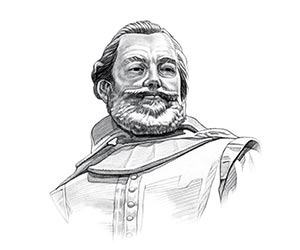John Smith Fact 1: John Smith was baptised on 6 January 1580. Baptism usually occurred 3 days after birth, but no birth records were kept, unlike Baptism records. He came from a family of farmers who were located near Alford, Lincolnshire, England.
John Smith Fact 2: John Smith was educated at King Edward VI Grammar School, Louth, from 1592–1595
John Smith Fact 3: In 1596 at the age of 16 John Smith started life at sea in the military and at first fought in the Netherlands.
John Smith Fact 4: John Smith then moved on to western Europe and joined a Christian army fighting the Turks in Hungary
John Smith Fact 5: The early escapades of John Smith earned him the rank of a captaincy and he was honored with a coat of arms which moved him up the social ranks in England.
John Smith Fact 6: In 1606 King James I of England granted a charter to the Virginia Company to establish colonies in Virginia.
John Smith Fact 7: Captain John Smith became involved on 20 December 1606 joined an expedition of three ships, the Discovery, the Susan Constant and the Godspeed, to the New World.
John Smith Fact 8: On the voyage John Smith clashed with Captain Christopher Newport who was in charge of the three ships. The situation between the 2 men was so bad that Captain Newport planned to execute him upon arrival in Virginia.
John Smith Fact 9: The execution never happened because when Captain Newport opened his sealed orders from the Virginia Company on April 26, 1607 he discovered, to his horror, that Captain John Smith had been designated as one of the leaders of the new colony.
John Smith Fact 10: In May 1607 the Jamestown settlement was established in Virginia.
John Smith Fact 11: The Powhatan Native Indians inhabited more than 100 surrounding villages. Within 2 weeks of the English arrival, deaths had occurred.
John Smith Fact 12: The Powhatan Confederacy was extremely powerful and their land covered 16,000 miles and the people of its 30 Indian tribes numbered 15,000.
John Smith Fact 13: By the Fall of 1607 More than half the colonists had died from disease, starvation and from wounds caused by Native Indians.
John Smith Fact 14: In December 1607 Captain John Smith was captured by a Powhatan hunting party and taken before Chief Powhatan (his Native Indian name Wahunsonacock).
John Smith Fact 15: Chief Powhatan had every intention to kill John Smith but his daughter, Pocahontas (Indian name Matoaka), saved the life of John Smith by coming between him and a blow from her father.
John Smith Fact 16: The encounter Powhatan leader and John Smith initiated a friendlier relationship between the natives and Smith and the colonists at Jamestown.
John Smith Fact 17: John Smith was released in January 1608.
John Smith Fact 18: Chief Powhatan, intrigued by the by the new tools and weapons, helped the Jamestown colony survive by supplying the colonists with food, which they traded for blue beads.
John Smith Fact 19: The friendly association between the Indians and the colonists, initiated by John Smith, resulted in a formal coronation of Chief Powhatan on September 10, 1608
John Smith Fact 20: The newly formed friendship soon deteriorated and tensions between the Indians and colonists rose when livestock, owned by the colonists, were allowed to wander into the Indian cornfields.
John Smith Fact 21: Dissent between the colonists also grew due to laziness and lack of supplies. Personal conflicts among John Smith and various leaders led to Captain John Smith leaving Jamestown to explore and map the Chesapeake Bay region and look for better foods supplies.
John Smith Fact 22: In September 1608 John Smith was elected president of the local council instituted a policy of discipline. "He who does not work, will not eat."
John Smith Fact 23: The Powhatan stopped trading with the colonists in an attempt to starve them out and the First Powhatan War erupted. The period covering the next 2 years (1609-1610) would become known as the 'Starving Time'.
John Smith Fact 24: In October 1609 John Smith was badly injured by a gunpowder burn and had to return to England for treatment
John Smith Fact 25: In London John Smith actively promoted the further colonization of Virginia but fell out with the Virginia Company.
John Smith Fact 26: In April 1614, John Smith returned to America exploring and mapping the Maine and Massachusetts Bay areas, which he named New England.
John Smith Fact 27: John Smith returned to England in 1615 where he concentrated on writing about the new colonies and the opportunities of America.
John Smith Fact 28: The books of John Smith such as The Generall Historie of Virginia and The True Travels…of Captain John Smith inspired people to immigrate to America - the passengers on the Mayflower ship had been motivated by his words.
John Smith Fact 29: John Smith died on June 21, 1631 in London, England. The cause of death was unspecified
John Smith Fact 30: Captain John Smith was buried in an Anglican church in Hoborn London at the St Sepulchre-without-Newgate, also known as the Church of the Holy Sepulchre. |
